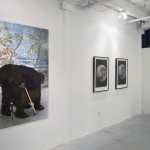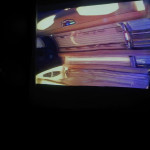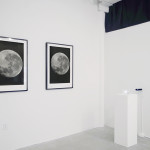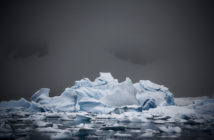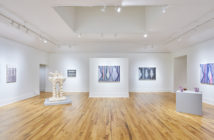Woander, curated by Corey Oberlander and Lindsey Stapleton and on view at GRIN until 29 August, confronts our heavily mediated relationship with nature. By calling attention to common clichés, taboos, past-times, and memories associated with our organic surroundings, the works by Raina Belleau, Andrea Wolf, Shamus Clisset, and Maria Molteni expose nature as a social, historical and culturally specific construct rather than an untouched ideal state. Far from being an explicit political critique that points the finger at our exploits of natural resources, the resulting climate change and other environmental catastrophes, Woander’s objective is more subtle and delivered with a sprinkling of humor. It calls attention to the paradox of our personal yearning for a return to an imagined communion with nature contrasted with our actual disconnect from and discomfort with our natural surroundings.
Combining an astute collection of man-made materials and anthropomorphism, Raina Belleau’s elaborate diorama-like installations allude to the human element and its effect on the natural world. In Porcupine and the Ghost Flag, Belleau created a setting whose central character is a faux-taxidermy porcupine made from zip-ties, foam, fake white fur, polymer clay, dowels, trash bags, nylon rope, chipboard, glass eyes, and acrylic paint. The animal sits on a log constructed from plywood and tree bark and is holding a stick skewering three cast hotdogs. This is not an attempt to create a true likeness—although the sausages had me momentarily fooled; Belleau’s animal actors are deliberately anthropomorphized to the extent where they become comic book characters, tapping into a childlike desire to communicate with our animal companions through a secret shared language.
Belleau's video installation, Brood, depicts the artist dressed in a camouflage costume, whooping crane puppets on both hands. Based on outfits worn by conservationist biologists in an effort to avoid avian/human bonding, the crane puppets pull raspberries from a bowl to feed the disguised mouth of the artist. The video exemplifies the artist’s and our own collective awkwardness towards nature—an ache to connect while remaining distanced and separate.
Shamus Clisset's photographic compositions are as crude and clunky as they are hilarious. The aesthetic crudeness, however, belies a meticulous process of digital appropriation, which sees Clisset using digital modeling software. The spaces and objects depicted are virtual environments, constructed and existing only within the realm of the computer. In order to render convincing views of these virtual constructions he uses raytracing software—a light-simulation program, which calculates how light would realistically interact with the objects, based on computer models of their surfaces and materials. The results are highly theatrical images that are suspended in imagined space between the real and the fake. “My aim in working this way is to treat the virtual space as very much real in its own right, as an alternate form of nature or wilderness with all the beauty and danger associated with it and to explore and inhabit it with my creations, much like a pioneer in a new frontier,” explains Clisset.
Mr. Realistic (Keeping America Clean) is a life-sized ray traced C-print of a homeless Merlin-like creature meets seaweed monster, set in the murder scene of a Law & Order episode. Rendered natural materials and textures are juxtaposed with cans and other trash hovering uncomfortably at disconcerting angles, defying traditional gravity and adhering instead to Clisset's own set forces.
Grizzly Chair focuses on a painstakingly rendered, larger-than-life bear skin chair taken from Seth Kinman’s 1865 version of a grizzly bear chair (Kinman was an early settler of Humboldt County, California, a hunter, chair maker and entertainer). Brute-force hunting tools and common luxury items such as a cocktail glass sit on and around the chair in front of whimsically painted floral wallpaper. The chair appears as a bizarre sideshow prop in a play that illustrates our enjoyment and revelry of the natural world combined with the urge for re-organization and control over it.
Maria Molteni’s projection room is a multi-sensorial affair. Upon entering, the viewer is enveloped in a slowly pulsing light that transitions through various color filters and is cued to the droning soundtrack of cicadas. The light emanates from a still image of a tanning bed projected life size onto one of the walls. The rest of the viewing room is drowned in darkness and empty except for a few organic objects like seashells and stones lining the walls. This collision of the natural versus the artificial seems a little forced and redundant at first, yet the warm glow of the tanning bed, reminiscent of Olafur Eliasson’s The Weather Project at the Tate Modern, blends with the haunting drone of the cicadas and goes under the skin.
In Andrea Wolf’s installation—perhaps the most aesthetically understated and serene in the exhibition—two photographic prints of the moon are juxtaposed with a small intimate projection of found-astronaut-footage from 1963. This formal chasm between scientific research imagery and home video triggers a barrage of contradictory emotions: an awe of the unknown, nostalgia, a sense of mystery and wonder and memories of backyard camping under the open night sky. Through its presentation of found ephemeral material, Wolf’s work proposes memory as both a personal and collective experience—wonder that is transferred and exchanged from person to person.
Woander is an intelligent and multi-layered show that doesn’t deliver easy answers; it doesn’t pick sides in the nature/nurture debate nor does it try to lecture its audience on environmentally responsible living. Instead, the works in the show mirror our complex, uncomfortable and often contradictory experience of and relationship with nature. There is an awkwardness, yearning and humor in the work that is honest and self-reflexive. It serves as a good starting point, not for a “return to nature,” but perhaps for a small shift in our perception of the organic world as part of a broader continuum—one to which we are already reciprocally connected as sensorial human beings.
Woander is on view at GRIN through August 29. An artists' talk will be held on Saturday, August 29 at 6PM.


